Nuclear Science and Technology - Volume 4, Number 1, March 2014
Results of Operation and Utilization of
the Dalat Nuclear Research Reactor
Nguyen Nhi Dien, Luong Ba Vien, Le Vinh Vinh, Duong Van Dong,
Nguyen Xuan Hai, Pham Ngoc Son, Cao Dong Vu
Nuclear Research Institute (NRI), Vietnam Atomic Energy Institute (VINATOM)
01 Nguyen Tu Luc, Dalat, Vietnam
(Received 5 March 2014, accepted 26 March 2014)
Abstract: The Dalat Nuclear Research Reactor (DNRR) with the nominal power of 500 kW was
reconstructed and upgraded from the USA 250-kW TRIGA Mark-II reactor built in early 1960s. The
renovated reactor was put into operation on 20th March 1984. It was designed for the purposes of
radioisotope production (RI), neutron activation analysis (NAA), basic and applied researches, and
nuclear education and training. During the last 30 years of operation, the DNRR was efficiently
utilized for producing many kinds of radioisotopes and radiopharmaceuticals used in nuclear medicine
centers and other users in industry, agriculture, hydrology and scientific research; developing a
combination of nuclear analysis techniques (INAA, RNAA, PGNAA) and physic-chemical methods
for quantitative analysis of about 70 elements and constituents in various samples; carrying out
experiments on the reactor horizontal beam tubes for nuclear data measurement, neutron radiography
and nuclear structure study; and establishing nuclear training and education programs for human
resource development. This paper presents the results of operation and utilization of the DNRR. In
addition, some main reactor renovation projects carried out during the last 10 years are also mentioned
in the paper.
Keywords: DNRR, HEU, LEU, RRRFR, RERTR, WWR-M2, NAA, INAA, RNAA, PGNAA.
I. INTRODUCTION
The DNRR is a 500-kW pool-type
reactor loaded with the Soviet WWR-M2 fuel
assemblies. It was reconstructed and upgraded
from the USA 250-kW TRIGA Mark-II reactor
built in early 1960s. The first criticality of the
renovated reactor was on the 1st November
1983 and its regular operation at nominal
power of 500 kW has been since March 1984.
The first fresh core was loaded with 88 fuel
assemblies enriched to 36% (HEU- Highly
Enriched Uranium).
In the framework of the program on
Russian Research Reactor Fuel Return
(RRRFR) and the program on Reduced
Enrichment for Research and Test Reactor
(RERTR), the DNRR core was partly
converted from HEU to Low Enriched
Uranium (LEU) with 19.75% enrichment in
September 2007. Then, the full core conversion
of the reactor to LEU fuel was also performed
from 24th November 2011 to 13th January 2012.
Recently, the DNRR has been operated with a
core configuration loaded with 92 WWR-M2
LEU fuel assemblies and 12 beryllium rods
around the neutron trap.
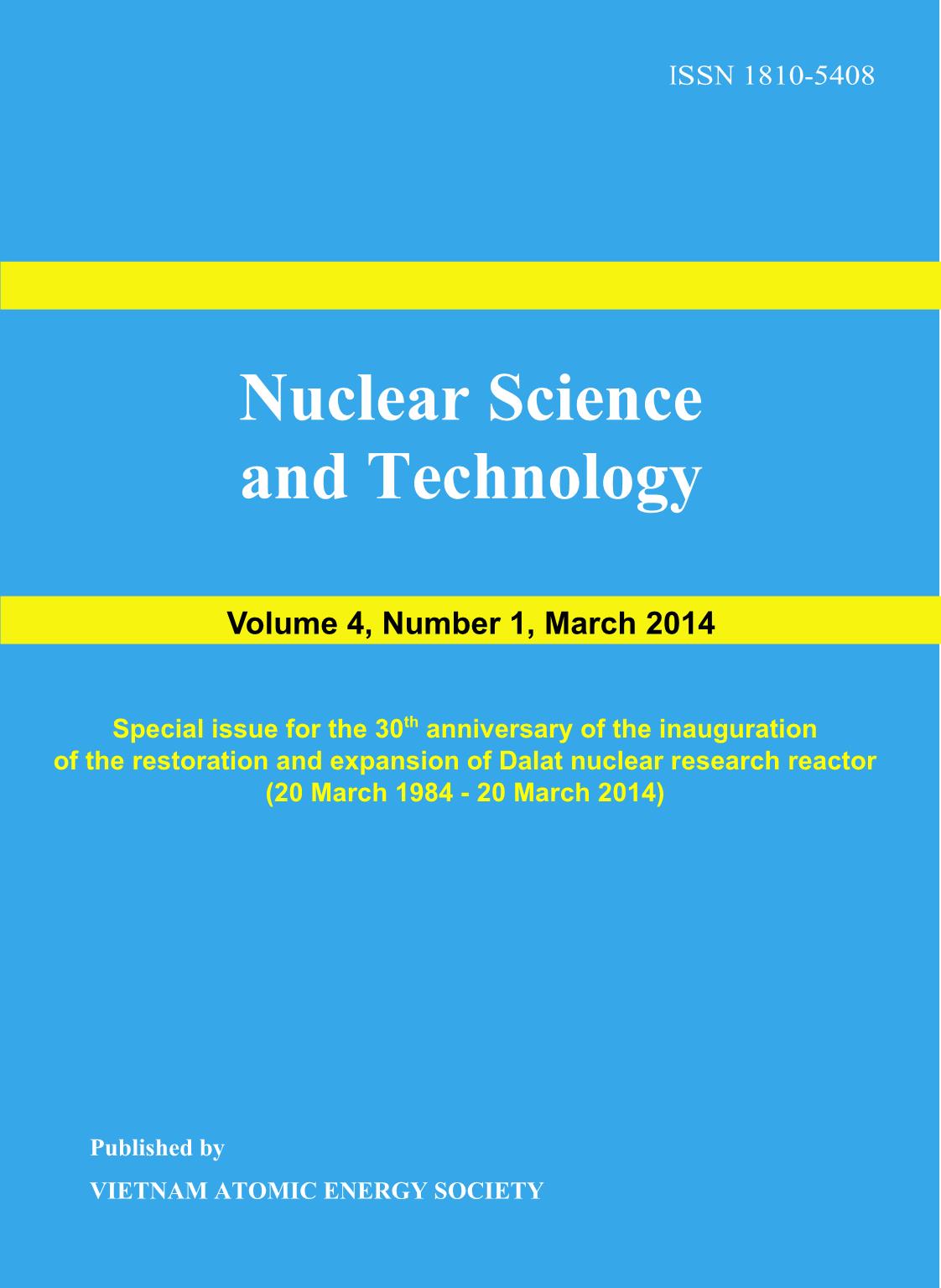
Trang 1
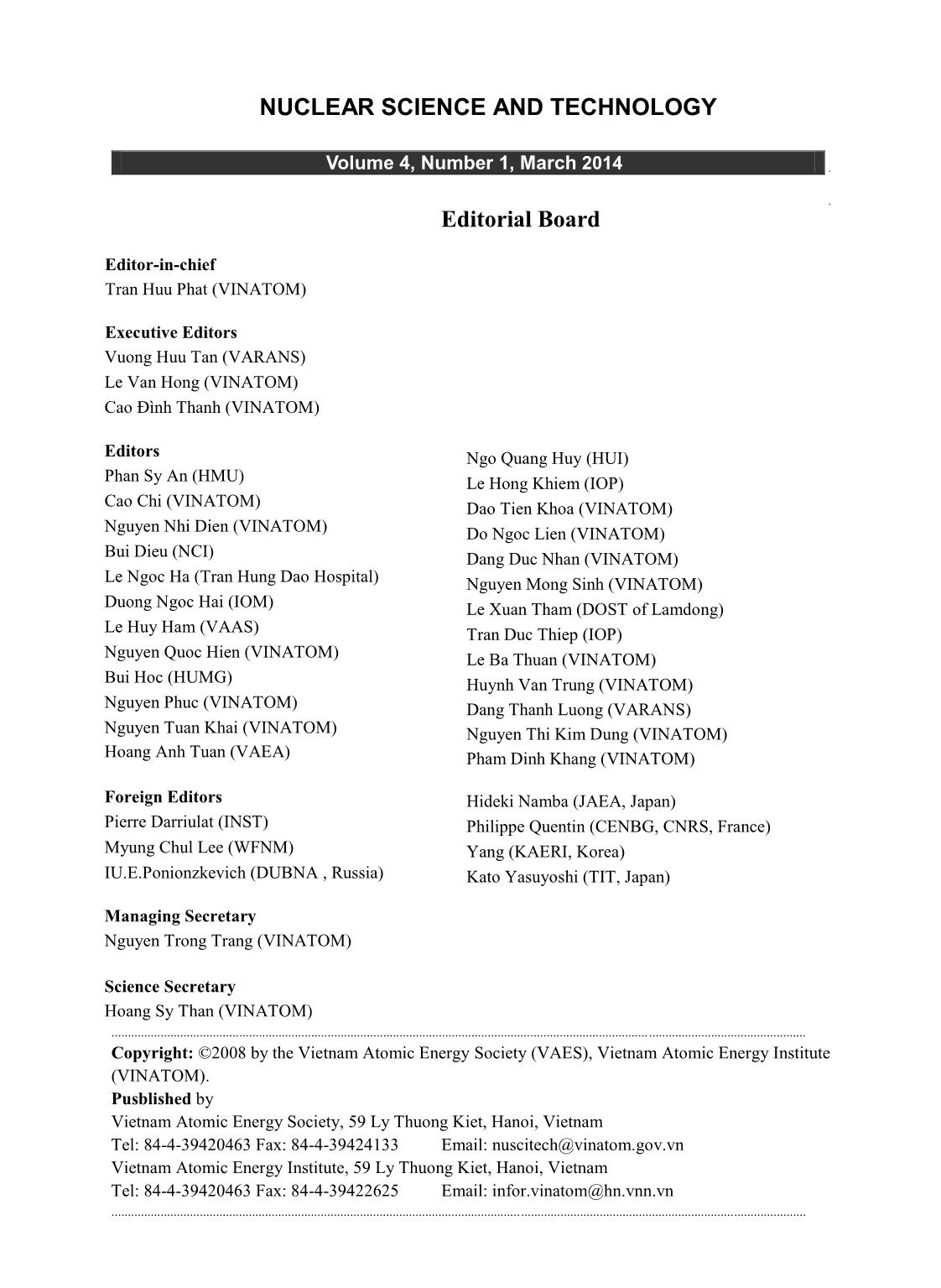
Trang 2
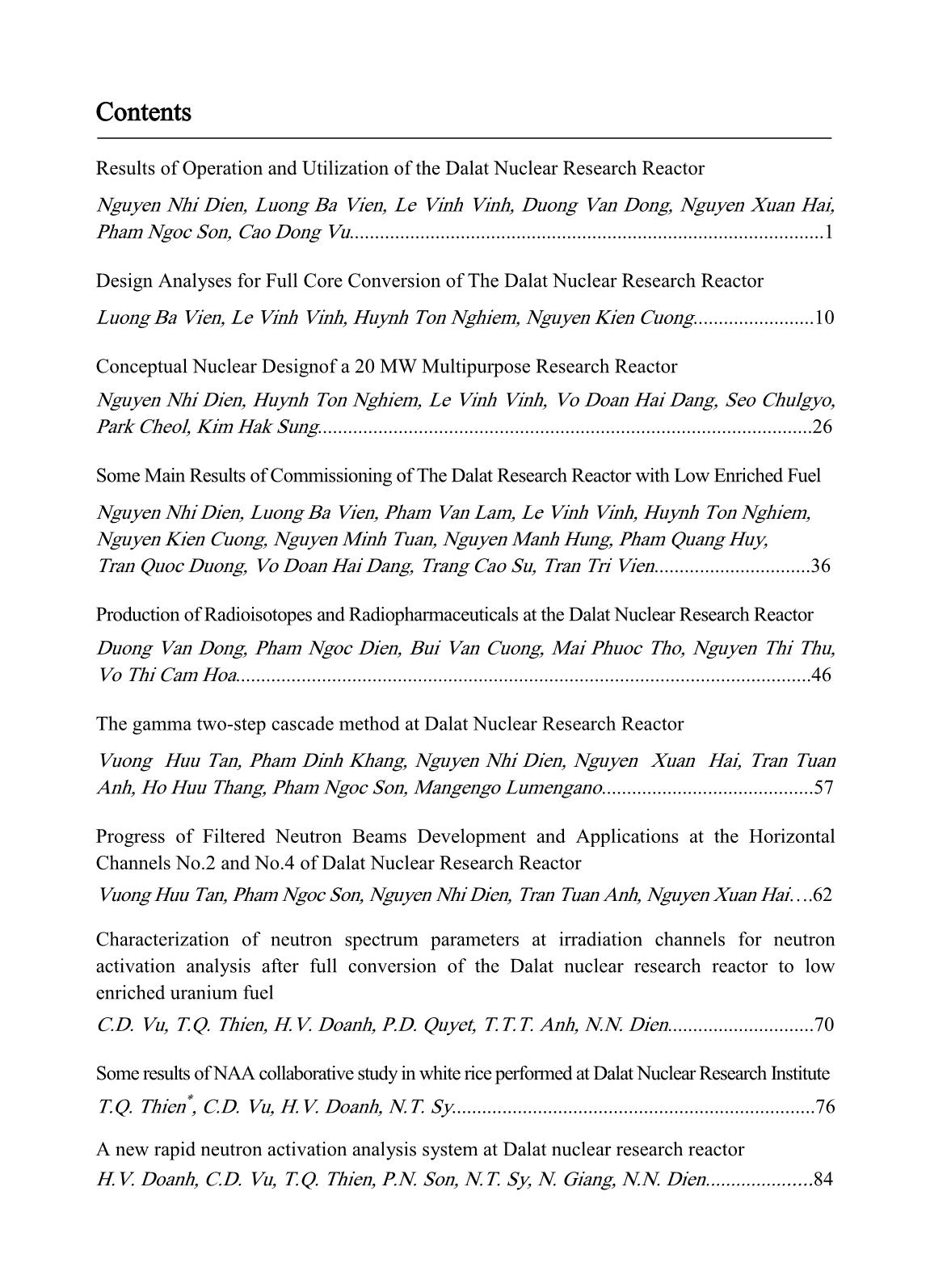
Trang 3
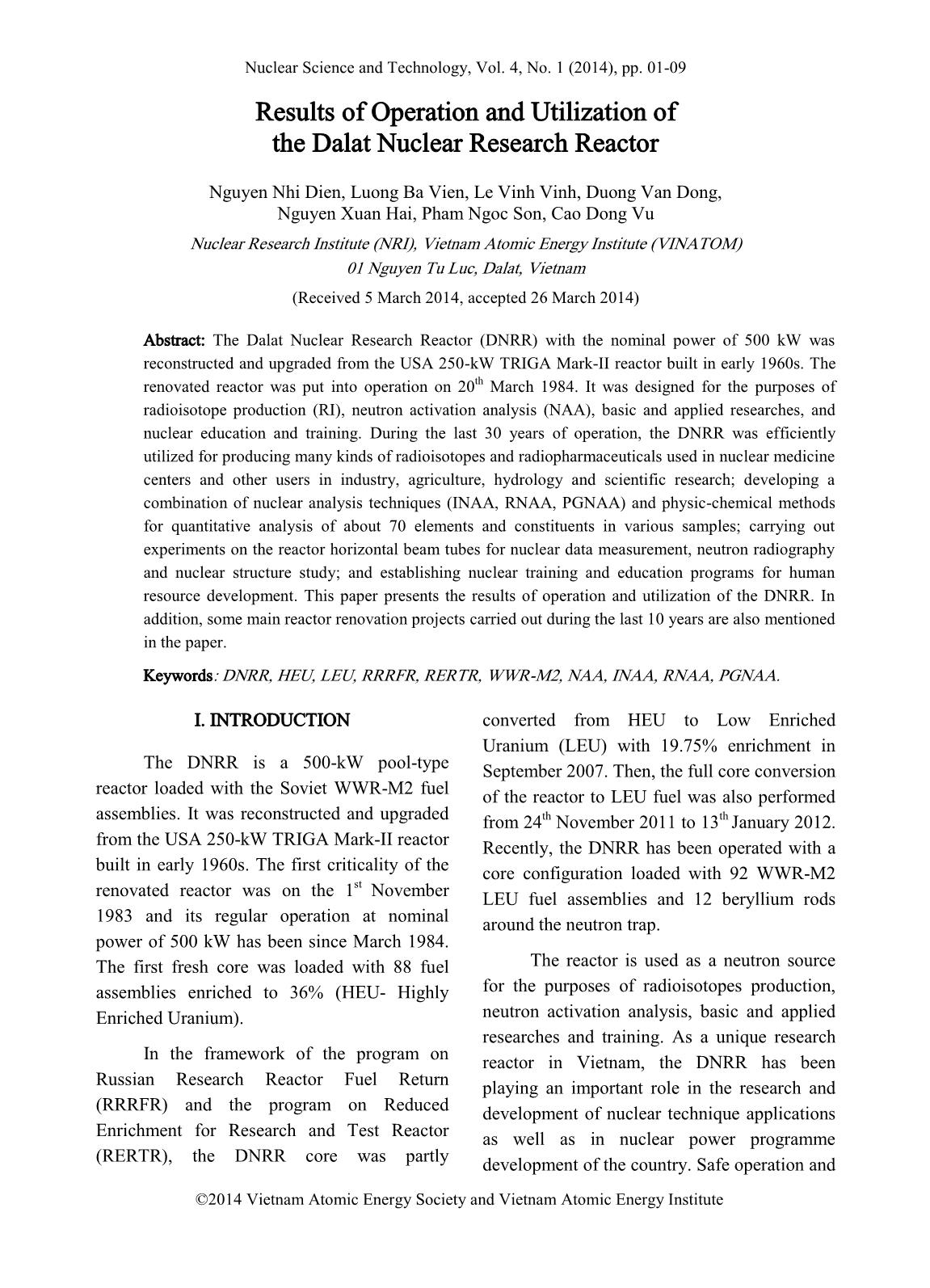
Trang 4
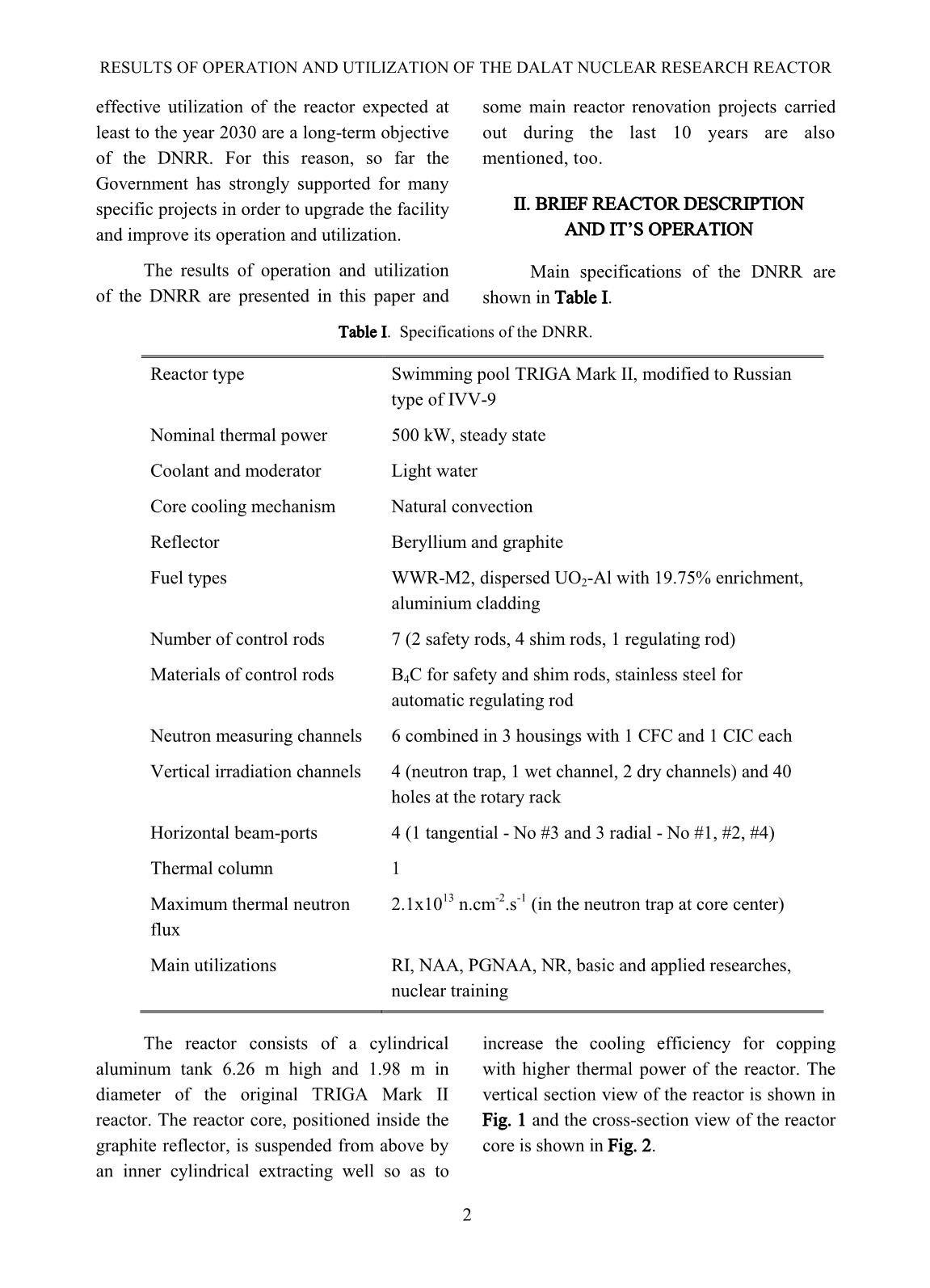
Trang 5
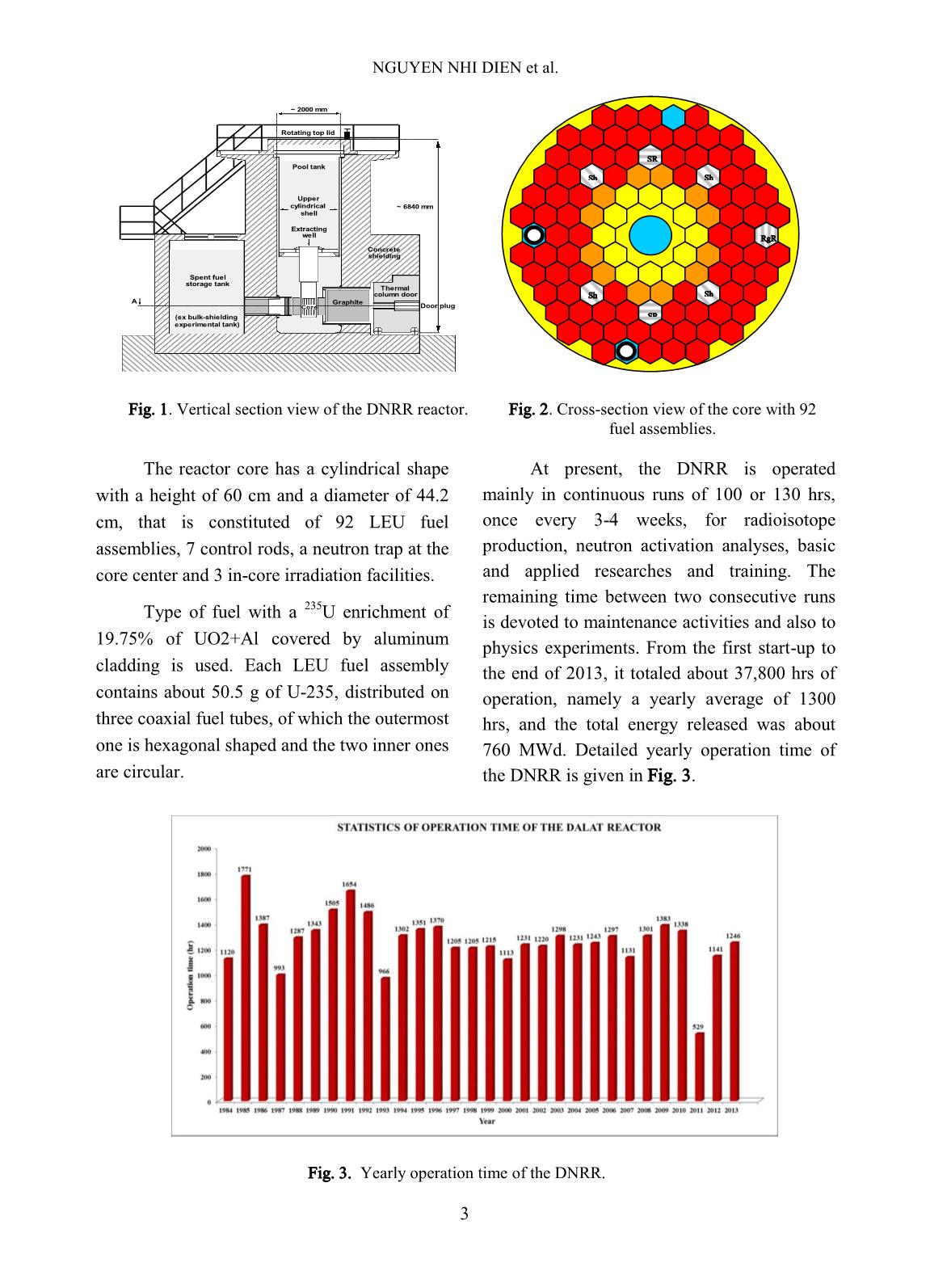
Trang 6
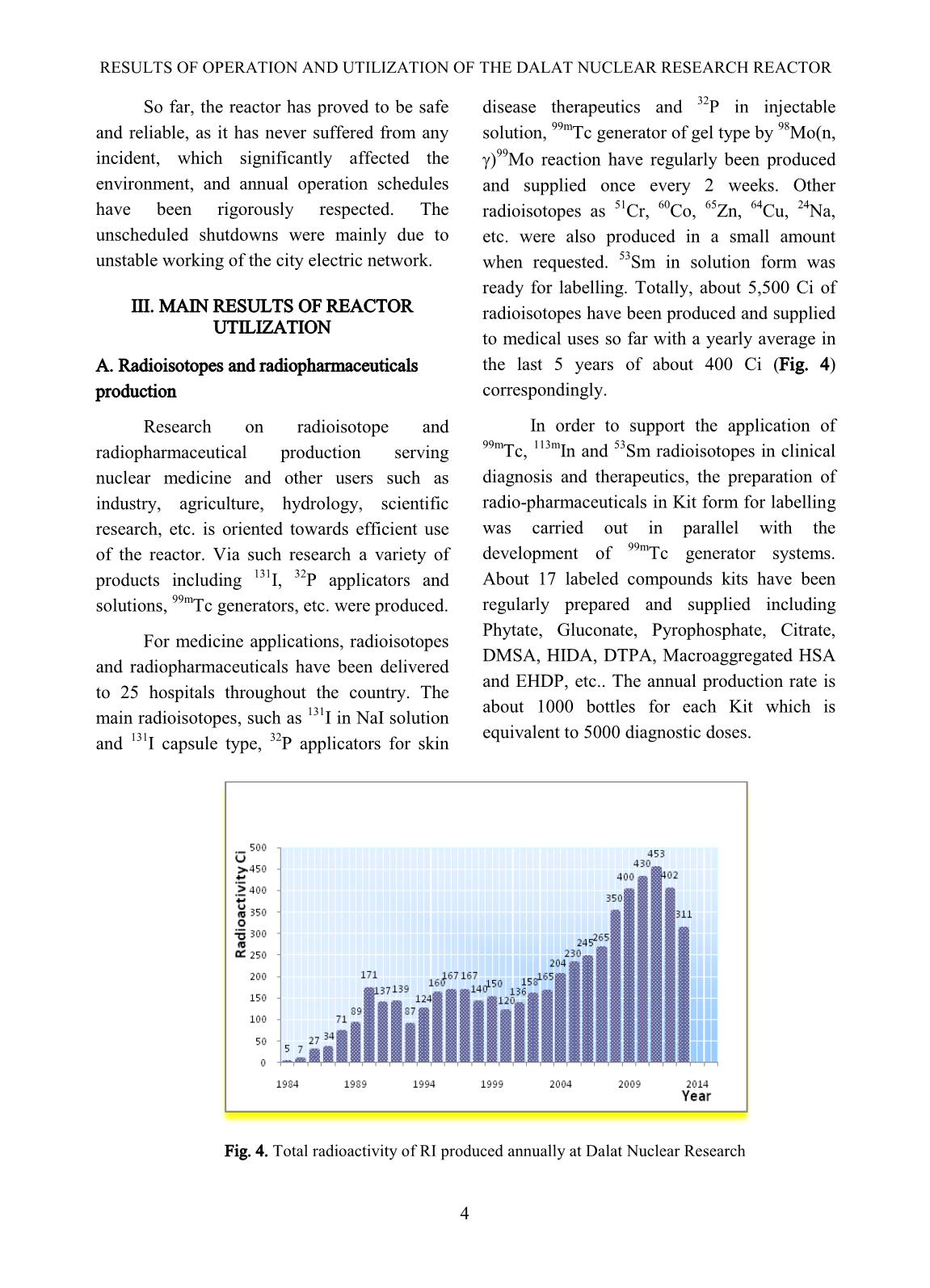
Trang 7
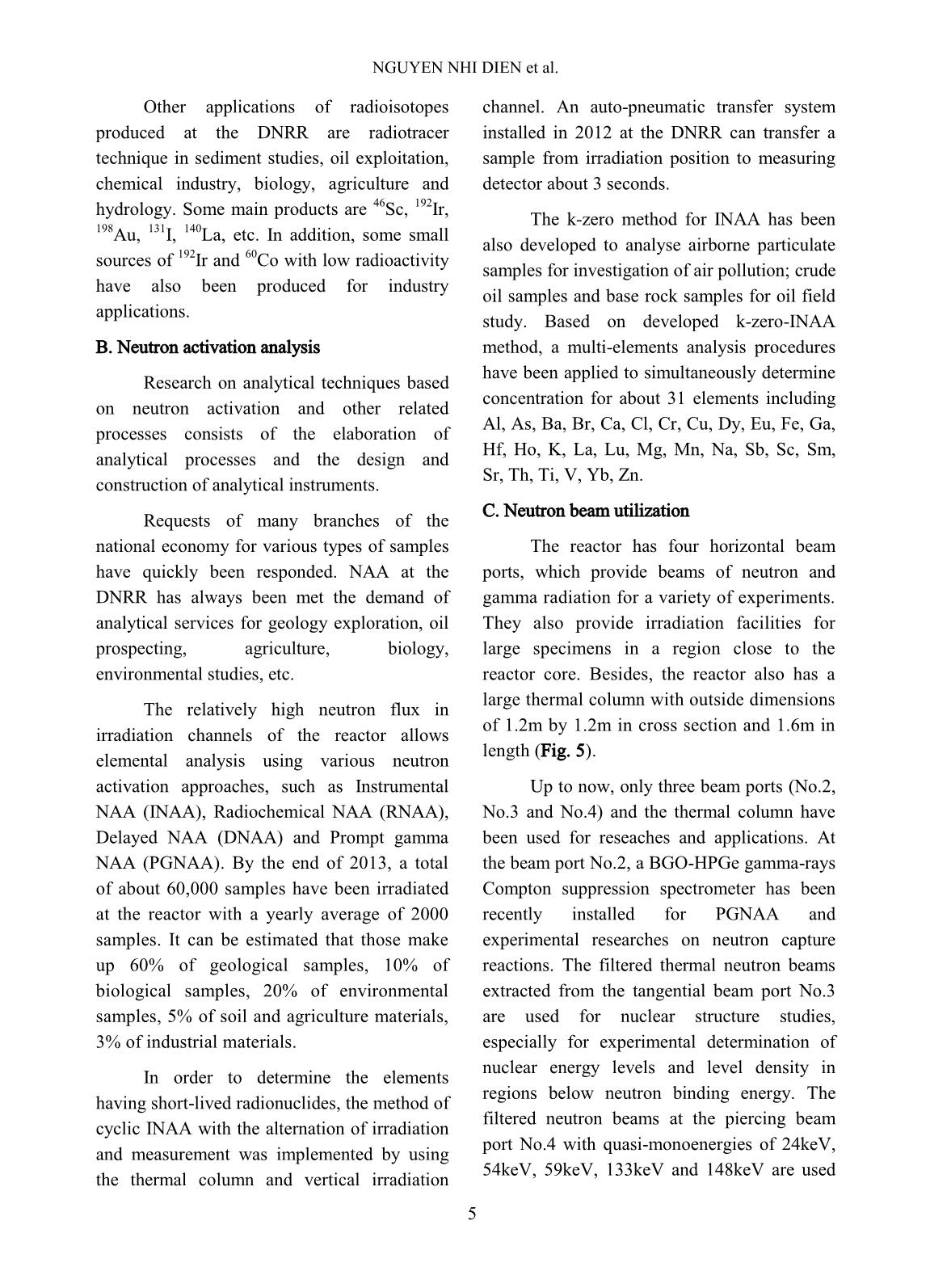
Trang 8
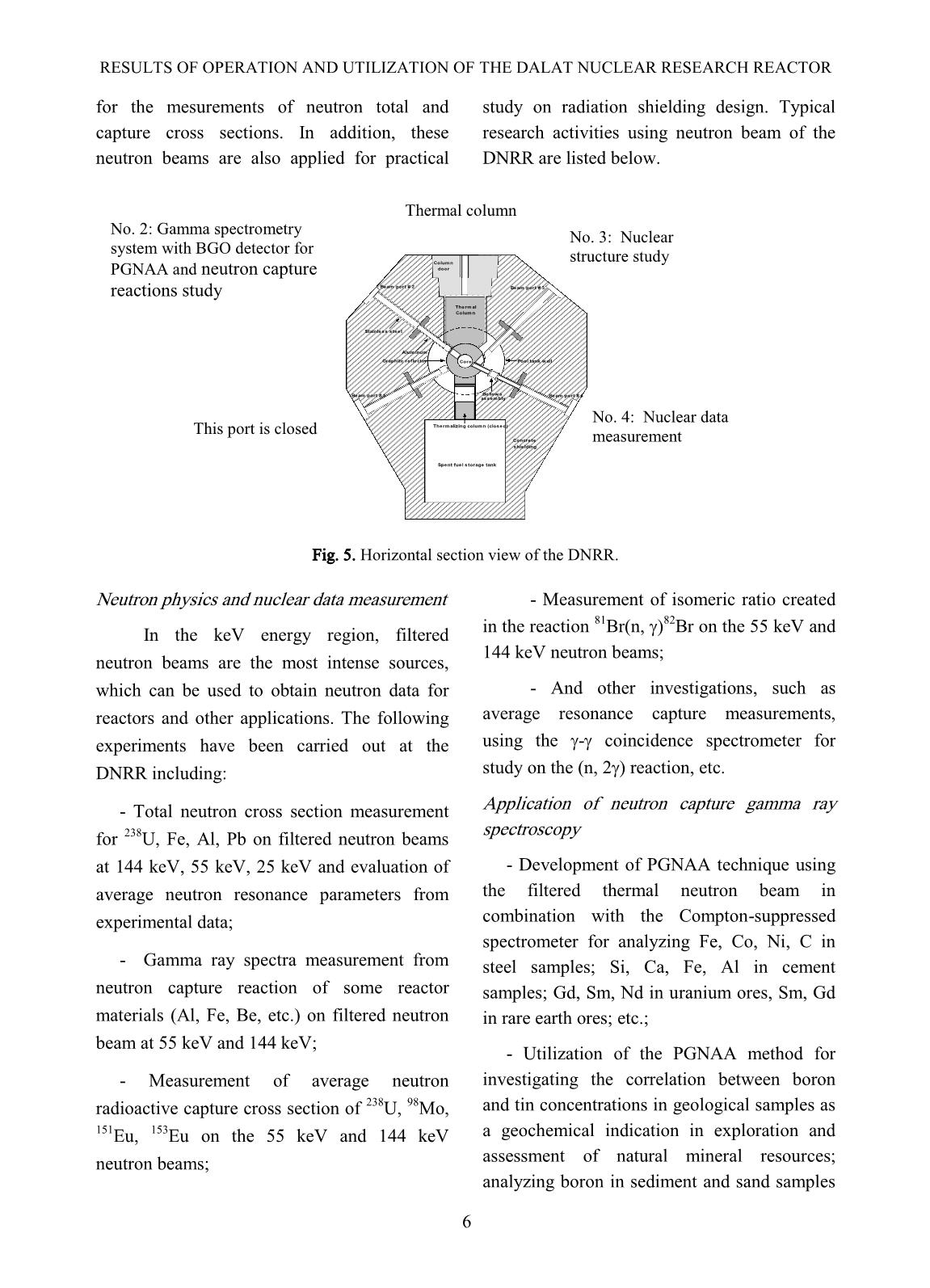
Trang 9
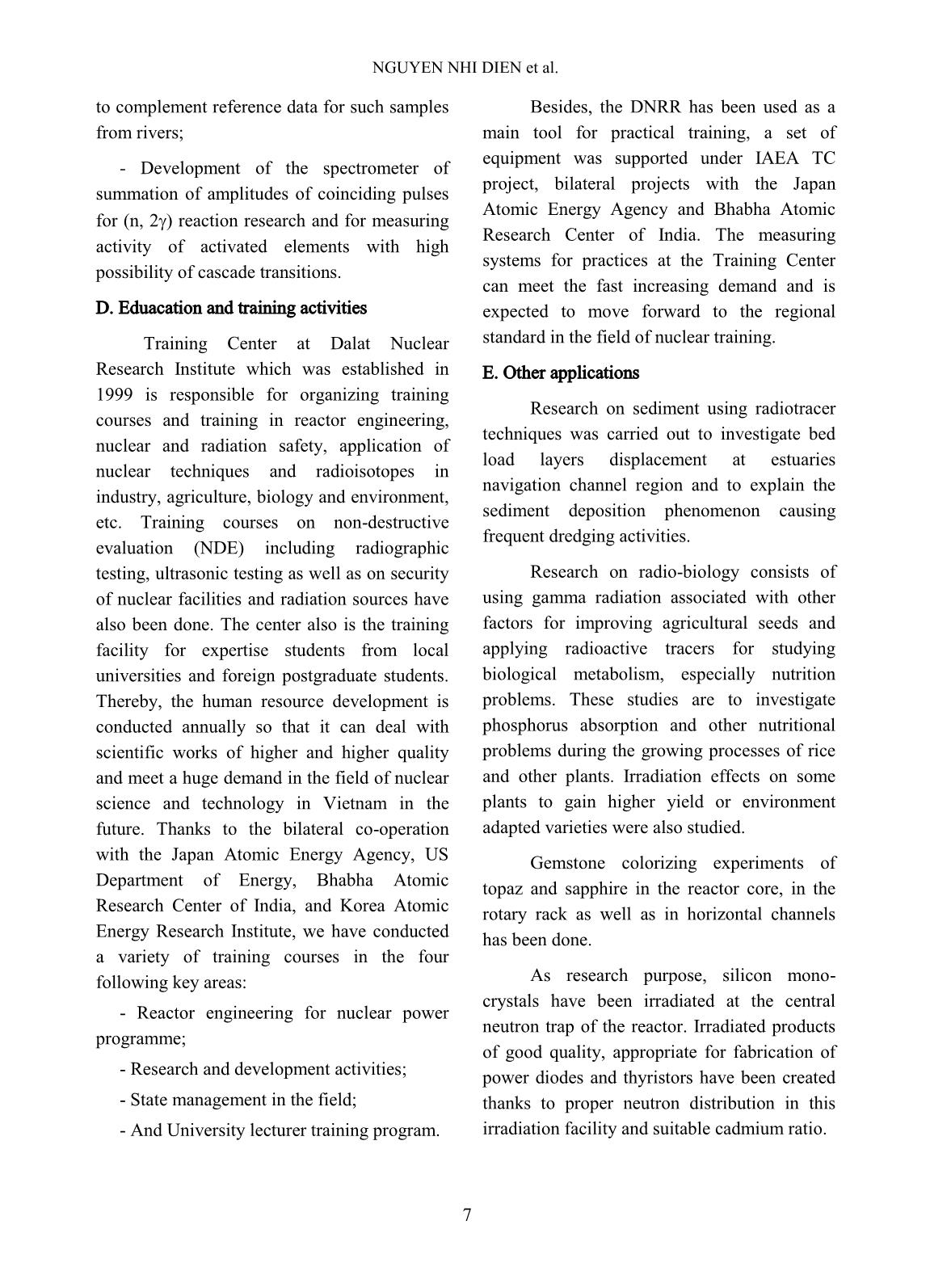
Trang 10
Tải về để xem bản đầy đủ
Tóm tắt nội dung tài liệu: Nuclear Science and Technology - Volume 4, Number 1, March 2014
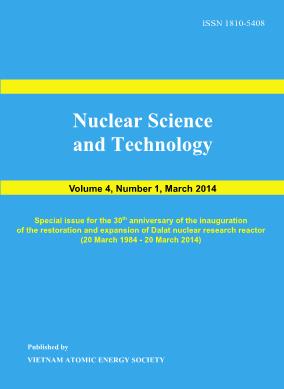
97 Zr with half-life of 16.7h. C. Determination of Selenium A variety of reference materials (Tuna Fish IAEA-436, Oyster tissue NIST 1566b, Bovine Liver NIST 1577, Bovine Liver NIST 1577b) were selected to assess reliability of this system on the short-time activation application. All of the samples were irradiated at a neutron flux of 4.2 1012 n.cm-2.s-1 in the 13-2 channel and counted on the calibrated HPGe gamma-ray spectrometer (GMX40-76- PL). In order to evaluate the limit of detection of Se in biological samples, two 200mg replicates of each material (IAEA 436 and NIST 1566b) were weighed and packed in high purity polyethylene bags. The samples were irradiated for 5, 10, 15, 20, 25, 30, 35 and 40 s. After a delay of 3.2 s (including both transferring time of sample from irradiation position to detector and the time required to start the detector). Each sample were counted for 20 s at a distance of 10 cm from detector. To test accuracy for the analysis of the Se concentration in biological reference materials, four 200 mg replicates of each material (IAEA 436, NIST 1566b, NIST 1577 and NIST 1577b) were weighed. The samples were irradiated for 25 s, allowed 20 s delay time to eliminate interference of 116m In with a half-life of 2.18 s [3, 4]) and counted for 25 s at a distance of 10 cm from the detector (GMX40-76-PL). The concentrations of Selenium were determined by both k-zero and relative methods. III. RESULTS AND DISSCUSION A. Timing measurements The results for average transferring time of sample from the top to bottom of the aluminum irradiation tube (Tin) is (0.628 0.021) s for the channel No.13-2 irradiation tube (a length of 6 m) and Tout is (0.323 0.030) s (averaged for 90 runs over the three days). For thermal column irradiation tube (a length of 2.8 m), Tin is (0.248 0.019) s and Tout is (0.146 0.004) s, as shown in Table II. The result obtained for measuring the return time from the irradiation position to the measurement position was found to be (3.165 ± 0.002) s for channel No.13-2. That for thermal column was (3.025 0.013) s. It should be noted that this timing parameters are included in the time required to start the detector after receiving the start signal. A NEW RAPID NEUTRON ACTIVATION ANALYSIS SYSTEM AT 88 Table II. The result of time measurements. Irradiation position The transferring time throughout aluminum irradiation tube (second) The return time from irradiation position to detector position (second) Tin Tout This word Manufacturer* 13-2 channel 0.628 0.021 0.323 0.030 3.165 ± 0.002 3.301 0.013 Thermal column 0.248 0.019 0.146 0.004 3.025 0.013 3.261 0.022 * Sample weight: 8 g for thermal column tube and 6 g for 13-2 channel tube, operation air pressure: 3.1 bars, distance: 30 meters. There are significant differences between this work and that of the manufacturer in capsule sample weight and distance from irradiation position to measurement position. Hence, there are differences ( 7%) in the result of the return time from irradiation position to detector position. However, it is not a problem for analytical measurements. Results for absolute irradiation time at channel No.13-2 and thermal column were determined by a series of irradiations ranging from 1 to 30 s (3 replicates), as shown in Fig. 3 and Fig. 4. The relative error of irradiation time in the first second is 16.02% for channel No.13-2 and 26.43% for thermal column, and those for irradiation time of 2 s is 1.5% for channel No.13-2 and 4.91% for thermal column. The relative error is less than 1% at irradiation time of 5 s for channel No.13-2, and 10 s for thermal column. The large error for the first second is due to delay of the system in starting the irradiation timer and in ejecting the capsule once the “end of irradiation” signal has been received. This timing delay problem can be adjusted through the control unit and the software package for managing optimal operation and the analytical procedures. However, it is not a problem for INAA because the time parameters remain unchanged for all samples, standards, and control material Fig. 3. The relative error of irradiation time for 13-2 channel. Fig. 4. The relative error of irradiation time for thermal column. 0 2 4 6 8 10 12 14 16 18 0 2 4 6 8 10 12 14 16 18 20 22 24 26 28 30 Irradiation time, second R e la ti v e e rr o r, % 0 4 8 12 16 20 24 28 0 2 4 6 8 10 12 14 16 18 20 22 24 26 28 30 Irradiation time, second R e la ti v e e rr o r, % HO VAN DOANH et al. 89 B. Neutron spectrum parameters of irradiation positions The results of the determination of neutron spectra parameters are shown in Table III. This table includes data obtained for the thermal, fast neutron flux, the ratio of thermal to epithermal neutron flux (th/epi). The thermal neutron flux at the irradiation position in the channel No. 13-2 is 4.2E+12 n.cm 2 .s -1 , and associated with 0.5 times of epithermal. The integral fast neutron flux is 6.61E+12 n.cm -2 .s -1 for all neutrons above 2.9MeV in energy [5], measured using the 58 Ni(n,p) 58 Co nuclear reaction. The thermal neutron flux at the irradiation position in the thermal column is 1.25E+11 n.cm 2 .s -1 , associated with much lower fast and epithermal neutron flux. Hence, thermal column is a useful irradiation channel for eliminating interference reactions induced by fast neutron, in which sample is irradiated in an extremely well thermalized neutron field [6]. Table III. The results of neutron spectra parameters at irradiation positions in the channel No.13-2 and thermal column of DNRR. Irradiation position th (n/cm 2 /s) F (n/cm 2 /s) epith / 13-2 channel (4.2 0.1) x 1012 (6.6 0.9) x 1012 10.7 2.4 Thermal column (1.24 0.03) x 1011 (8.4 0.5) x 108 195 4 C. Determination of Selenium Finally, measurements of detection limits of Se in IAEA 436 and NIST 1566b samples were performed. The results for these measurements are presented in Fig 4. The obtained results confirm that in irradiation from 15 s to 25 s at irradiation position of the channel No.13-2 coupled with counting for roughly 20 s at 10 cm distance from detector, the detection limits for Se is within the range 0.5 0.7 ppm, depending on the sample composition. It provides adequate analytical sensitivities for Se rapid determination in a variety of biological matrices. The accuracy for determination of Selenium using the short-lived nuclide 77m Se was evaluated by analyzing a number of certified reference materials with different levels of Se (IAEA 436, NIST 1566b, NIST 1577 and NIST 1577b). The agreement between measured and certified values was generally very good with u-score < 1.64, as shown in Table IV. 0.2 0.4 0.6 0.8 1.0 1.2 1.4 1.6 1.8 0 5 10 15 20 25 30 35 40 45 Irradiation time, second d e te c ti o n l im it , p p m NIST 1566b IAEA 436 Fig. 4. The detection limits of Se in IEAE 436 and 1566b. A NEW RAPID NEUTRON ACTIVATION ANALYSIS SYSTEM AT 90 For the determination of the Selenium by the instrumental neutron activation analysis, the long-lived nuclide 75 Se or the short-lived nuclide 77m Se can be used [7]. With the short- lived nuclide, not only completion times are a distinct advantage but analytical sensitivities are also improved. The data for procedures are listed in Table V. Table IV. The results of concentration analysis for Se in biological reference materials. Reference material Certificated value (in ppm) k-zero method The relative method This work (in ppm) u-score This work (in ppm) u-score IAEA 463 4.63 0.48 4.55 0.50 0.12 4.19 0.46 0.66 NIST 1566b 2.06 0.15 2.48 0.57 0.71 2.18 0.42 0.27 NIST 1577 1.10 0.10 1.24 0.31 0.43 1.17 0.22 0.29 NIST 1577b 0.73 0.06 0.70 0.11 0.24 0.80 0.17 0.39 Table V. Parameters were used for INAA analysis of Selenium in biological sample by using 77m Se and 75 Se isotopes. Radionuclide 75 Se 77m Se Half-life 120 d 17.4 s Activation 20 h at 3.5 x 10 12 (n/cm 2 /s) 1525 s at 4.2 x 10 12 (n/cm 2 /s) Decay time 20 d 20 s Counting time 23 h 25 s Detection limit 1.4 ppm 0.6 ppm Sample: IAEA 436 4.63 ± 0.48 ppm 4.63 ± 0.48 ppm The results 4.35 ± 1.1 ppm 4.19 ± 0.46 ppm IV. CONCLUSION A fast pneumatic sample transfer system for analyzing of extremely short-lived nuclides by neutron activation analysis has been installed and operated at Dalat nuclear research reactor. In this study, time parameters of the system were calibrated, thereby reducing irradiation time to seconds with precision. Neutron spectra parameters of the thermal column and channel No.13-2 were also determined in order to establish analytical procedures using the k0-NAA method. The system was applied to determine the concentration of Se in the biological sample by using the short-lived nuclide 77m Se. The results obtained through this research have opened a new possibility on using INAA technique for measurement of extremely short-lived nuclides at Nuclear Research Institute. HO VAN DOANH et al. 91 ACKNOWLEDGEMENTS This project was carried out under the nuclear research and development program of the Ministry of Science and Technology, Vietnam. REFERENCES [1] S.S. Ismail, A new automated sample transfer system for instrumental neutron activation analysis, journal of Automated Methods and Management in Chemistry, Vol. 2010, (2010). [2] Yong-Sam Chung, et al., Characteristics of a new pneumatic transfer system for a neutron activation analysis at the HANARO research reactor, Nuclear Engineering and Technology, Vol. 41, No. 6, p. 813 (2009) [3] U.M. El-Ghawi, et al., Determination of Selenium in Libyan Food Items Using Pseudocyclic Instrumental Neutron Activation Analysis, Biological Trace Element Research, Vol. 107, p. 61 (2004). [4] L.S. McDowell, et al., Determination of Selenium in individual food items using the short-lived nuclide 77m Se, Journal of Radioanalytical and Nuclear Chemistry, Vol. 110, No. 2, p. 519 (1987). [5] A. D. Becker, Characterization and use of the new NIST rapid pneumatic tube irradiation facility, Journal of Radioanalytical Chemistry, Vol. 233, No. 1-2, p. 155 (1998). [6] R. Gwozdz, F. Grass, J. Dorner, Fluorine analysis of standard materials by short-time activation analysis using 20 F, Journal of Radioanalytical and Nuclear Chemistry, Vol. 169, No.1, p. 57 (1993). [7] D. Behni, et al., Combination of Neutron Activation Analysis, Tracer Techniques, and Biochemical Methods in the Investigation of Selenium Metabolism, Journal of Radioanalytical and Nuclear Chemistry, p.439 (1989). INSTRUCTIONS FOR AUTHORS GENERAL INFORMATION Nuclear Science and Technology (NST), an international journal of the Vietnam Atomic Energy Society (VAES), quarterly publishes articles related to theory and application of nuclear science and technology. All papers and technical notes will be refereed. It is understood that the paper has been neither published nor currently submitted for publication elsewhere. The copyright of all published papers and notes will be transferred in VAES. DETAILED FIELDS NST coves all fields of nuclear science and technology for peaceful utilization of nuclear energy and radiation. Authors should choose one of the following fields at the time they submit their manuscript: 1) Nuclear Physics, 2) Nuclear Data, 3) Reactor Physics, 4) Thermal Hydraulics, 5) Nuclear Safety, 6) Nuclear I&C, 7) Nuclear Fuel and Materials, 8) Radioactive Waste Management, 9) Radiation Protection, 10) Radiation Technology, 11) Nuclear Techniques in Food and Agriculture, 12) Nuclear Medicine and Radiotherapy, 13) Nuclear Techniques in Industries, 14) Environment Radioactivity, 15) Isotope Hydrology, 16) Nuclear Analytical Methods, 17) Health Physics, 18) Fusion and Laser Technology. MANUSCRIPT SUBMISSION Manuscript for publication should be submitted to the Editorial Office in triplicate by postal mail. For electronical submission use nuscitech@vinatom.gov.vn. Submission Address Department of Planning, R&D Management Vietnam Atomic Energy Institute, 59 Ly Thuong Kiet Street, Hanoi, Vietnam E-mail: nuscitech@vinatom.gov.vn. MANUSCRIPT PREPARATION Manuscripts must be written in English with adequate margins and indented paragraph. All manuscript must use SI (metric) units in text, figures, and tables. Manuscripts should in general be organized in the following order: title, names of authors and their complete affiliation including zip code, abstract (not exceeding 200 words), keywords (up to 7), introduction, main body of a paper, acknowledgments, references, appendices, table & figure captions, tables and figures. Unnecessary sections may be omitted. Headings: Use I, II, for major headings and A, B, for secondary headings. Mathematical formulas: All mathematical formulas should be clearly written, with special consideration to distinctive legibility of sub-and superscripts. Equation (at least the principal ones) should be numbered consecutively using Arabic numerals in parentheses in the right hand margin. Tables and Figures: Tables should be numbered with Roman numerals. Figures should be numbered consecutively with Arabic numerals in order of their first appearance and have a complete descriptive title. They should be typed on separate sheets. Tables should no repeat data which are available elsewhere in the paper. Figures should be original ink drawing or computer drawn figures in the original and of high quality, ready for direct reproduction. Figures should be referred to in the text as, for example, Fig. 1., or Fig. 2. . Reference: References should be listed at the end of the text and presented as follows: [1] C. Y. Fu et al., Nuclear Data for Science and Technology, S. M. Qaim (Ed.), p. 587 (1991). [2] C. Kalbach, Z. Phys, A283, 401 (1977). [3] S. Shibata, M. Imamura, T. Miyachi and M. Mutou, “Photonuclear spallation reactions in Cu”, Phys. Rev. C 35, 254 (1987). KHOA HỌC VÀ CÔNG NGHỆ HẠT NHÂN Chịu trách nhiệm xuất bản TRẦN HỮU PHÁT Chịu trách nhiệm nội dung TRẦN HỮU PHÁT TRẦN CHÍ THÀNH LÊ VĂN HỒNG CAO ĐÌNH THANH Trình bày LÊ THÚY MAI In 200 cuốn, khổ 19x26,5cm tại Công ty Mỹ thuật Trung ương Giấy đăng ký kế hoạch xuất bản số: 770/GP-BTTTT cấp ngày 20 tháng 5 năm 2011 In xong và nộp lưu chiểu Quý I năm 2014 25 000đ
File đính kèm:
 nuclear_science_and_technology_volume_4_number_1_march_2014.pdf
nuclear_science_and_technology_volume_4_number_1_march_2014.pdf

